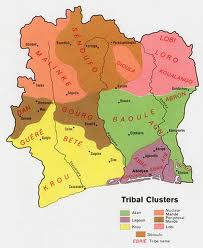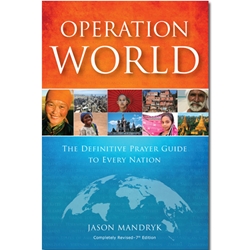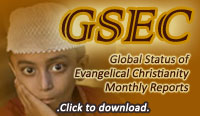 How can we effectively measure progress in our efforts to to fulfill the Great Commission? One way is to measure the growth of global Christianity. The IMB Global Research Department has committed themselves to conducting the same research for a long time. They have built a database of people groups and annually measure the strength of churches among each people group. They call this the Global Status of Evangelical Christianity (GSEC). Click to download the data and view reports, which are updated monthly.
How can we effectively measure progress in our efforts to to fulfill the Great Commission? One way is to measure the growth of global Christianity. The IMB Global Research Department has committed themselves to conducting the same research for a long time. They have built a database of people groups and annually measure the strength of churches among each people group. They call this the Global Status of Evangelical Christianity (GSEC). Click to download the data and view reports, which are updated monthly.
Research
Change in Missions
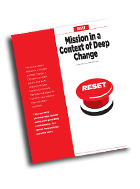 Steve Moore at The Mission Exchange has written a great article about change and our current environment in missions. His purpose is to set the tone for the 2011 North American Mission Leaders Conference, but even those who aren’t planning to attend this event would be well served to give this article a read. Steve argues that we are on the precipice of great change in missions. Our world is rapidly changing and missions agencies are part of this change. The economic times in which we live are those which have historically caused “reset” moments that brought about great change. He explores three main concepts:
Steve Moore at The Mission Exchange has written a great article about change and our current environment in missions. His purpose is to set the tone for the 2011 North American Mission Leaders Conference, but even those who aren’t planning to attend this event would be well served to give this article a read. Steve argues that we are on the precipice of great change in missions. Our world is rapidly changing and missions agencies are part of this change. The economic times in which we live are those which have historically caused “reset” moments that brought about great change. He explores three main concepts:
- Sand Pile Effect (unpredictable interconnectedness) – how one small thing can cause an avalanche of change
- IED Effect (asymmetrical influence) – how small, unestablished organizations can be major players
- Jailbreak Effect (open-source creativity) – how breakthrough ideas can come from those we don’t consider experts
He asks three key questions:
- How do we fund the Great Commission?
- How do mission organizations and local churches work together in the Great Commission?
- How does the North American church relate effectively with the church in the majority world?
Things to Learn in Your First Month on the Field
 Now that you have what you need to survive, it’s time to buckle down and become a learner. You need to meet people, ask questions, and write things down. Here is a simple list to get you started. This is taken from “Getting Acquainted with Your New Home” by Orville Jenkins.
Now that you have what you need to survive, it’s time to buckle down and become a learner. You need to meet people, ask questions, and write things down. Here is a simple list to get you started. This is taken from “Getting Acquainted with Your New Home” by Orville Jenkins.
Things to learn
- How do I say hello?
- How do I say goodbye?
- How, what, and when do people eat?
- How to behave as a guest in someone’s house?
- How much space is personal space?
- How late is late?
- What is immodest?
- What clothing is appropriate?
- What are appropriate and inappropriate relationships toward the opposite sex?
- What are appropriate and inappropriate gestures?
- What are appropriate and inappropriate forms of physical contact?
- What are the roles of family members?
- What are the rites or special occasions during someone’s life?
- What are the defining parts of the history?
- What aspects of history or politics should not be discussed?
- Who are the majors heroes or figures who have shaped the nation?
- When are the holidays?
- What is the structure of the government?
- When are the elections?
- What is the relationship between the national and local government?
- What are the major political parties?
- What are the titles for those in authority?
- What is the legal process?
- How should I respond towards the police?
- What things would I need permission for?
- What rights do I have?
- What should I do if I am involved in a vehicle accident?
- What should I do if my house is broken into?
- What is the budget for an average family for one month?
- What are the main industries?
- What is the main source of news?
- What magazines are widely read?
- What are the major radio stations?
- What are the marriage customs?
- What are the burial customs?
- What are the religious customs?
- Where are the places of worship?
- What are the folk beliefs?
Maps
Are you looking for a good map of your area? If you are like most missionaries, it helps to visualize where you work with a map. I like to have a large political map for general reference, a map of the locations where I work, and a handy atlas to look up places. Look for these items at a bookstore that sells school textbooks. If your map is laminated you can write on it with a dry erase marker. You should also take advantage of the missions maps that are available, showing percent evangelical, bible translation, church strength and other valuable information. With Google Earth and more technical GIS software, you can create your own custom maps, showing the churches, schools, clinics, or other places you serve. Here are some links to maps.
Missions Maps
Online Maps
Mapping Software
Operation World Wall Map
Operation World is releasing a wall map in conjunction with its 2010 updated book. The world map is 24″ x 36″ and includes statistics, three inset maps, and a digital version of the map. The price is $8.49 folded, $9.99 flat, and $12.99 laminated from GMI.
Operation World Updated Edition Coming Soon
Jason Mandryk is releasing the 7th edition of Operation World in October 2010. This completely revised edition is helpful tool for praying for the people of our world. $20 paperback, $22 hardback, $20 CD, $30 database DVD.
World Clock
Here is a nice tool from Poodwaddle.com that displays useful statistics.
Etnopedia
 Do you want to learn more about a particular unreached people group? Do you want to share information about the people group you serve? Are you multi-lingual and willing to translate important missions research into other languages? Etnopedia is a website that seeks to share information about unreached people groups for the purpose of prayer, mobilization, and planning. As the name suggests it uses the wiki software and is similar to Wikipedia. Check it out and contribute your information or translate.
Do you want to learn more about a particular unreached people group? Do you want to share information about the people group you serve? Are you multi-lingual and willing to translate important missions research into other languages? Etnopedia is a website that seeks to share information about unreached people groups for the purpose of prayer, mobilization, and planning. As the name suggests it uses the wiki software and is similar to Wikipedia. Check it out and contribute your information or translate.
Harvest Information System
 Have you ever found yourself talking with a co-worker from another mission organization and discovered that you have different terminology for the same thing? Did you ever wish someone would write a glossary to explain that “World A” equals “the 10/40 window,” “Australasia” equals “Oceania” and so on? What if I count Somalia as part of East Africa while you count it as part of the Horn of Africa. Imagine the increased complexity when using multiple databases for measuring lostness and progress in the task of global evangelization. The Harvest Information System is a collaborative effort to establish a system that mission agencies can use to link their database together and be on the same page in their research. Several “registries” have been established, adopted by a custodian organization, and shared in database formats for researchers to use. The following are links to information about the current registries.
Have you ever found yourself talking with a co-worker from another mission organization and discovered that you have different terminology for the same thing? Did you ever wish someone would write a glossary to explain that “World A” equals “the 10/40 window,” “Australasia” equals “Oceania” and so on? What if I count Somalia as part of East Africa while you count it as part of the Horn of Africa. Imagine the increased complexity when using multiple databases for measuring lostness and progress in the task of global evangelization. The Harvest Information System is a collaborative effort to establish a system that mission agencies can use to link their database together and be on the same page in their research. Several “registries” have been established, adopted by a custodian organization, and shared in database formats for researchers to use. The following are links to information about the current registries.
The World is Flat
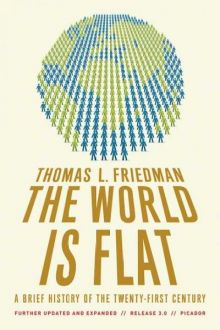 In The World is Flat, Thomas Friedman, foreign affairs columnist for the New York Times, describes how the world has become a more equal playing field to many of its people and the resulting implications. Friedman begins his book by giving examples of global out-sourcing and the extent of global communication. He explains how new technology has resulted in creating a level playing field, or a “flat world,” for workers in other countries. He then seeks to explain how this has happened. Friedman lists and describes the ten “flatteners” that created the flat world. These include the fall of the Berlin wall and the rise of Microsoft Windows, the release of Netscape, work flow software, open-sourcing, outsourcing, offshoring, supply-chaining, insourcing, in-forming, and the “steroids,” – those things that made made the other “flatteners” more digital, mobile, personal, and virtual.
In The World is Flat, Thomas Friedman, foreign affairs columnist for the New York Times, describes how the world has become a more equal playing field to many of its people and the resulting implications. Friedman begins his book by giving examples of global out-sourcing and the extent of global communication. He explains how new technology has resulted in creating a level playing field, or a “flat world,” for workers in other countries. He then seeks to explain how this has happened. Friedman lists and describes the ten “flatteners” that created the flat world. These include the fall of the Berlin wall and the rise of Microsoft Windows, the release of Netscape, work flow software, open-sourcing, outsourcing, offshoring, supply-chaining, insourcing, in-forming, and the “steroids,” – those things that made made the other “flatteners” more digital, mobile, personal, and virtual.
The next section looks at how the US should react to a flat world. He encourages American workers to work harder and develop more knowledge and creative jobs that cannot be as easily outsourced. He outlines recommendations for educational, economic, and political changes that the US should make to remain a world leader. Friedman then turns his focus to the underdeveloped world and the Islamic world. He looks at the reasons that opportunities are limited in these nations and what could be done so that the individuals in these nations can enter the flat world. He looks at global politics and causes of terrorism.
Citing numerous examples and drawing from his vast wealth of personal interviews, Friedman illustrates his points with skill. He uses examples from corporations, both large and small, governments, and non-governmental organizations to explain how the flat world principles work. This book explains what we see happening in the world around us and show how recent breakthroughs fit together like puzzle pieces to form our modern world. He explains why certain things that may seem insignificant are actually major shifts that have shaped the last fifteen years. Applications may be made in political, vocational, religious, and organizational facets of life.
